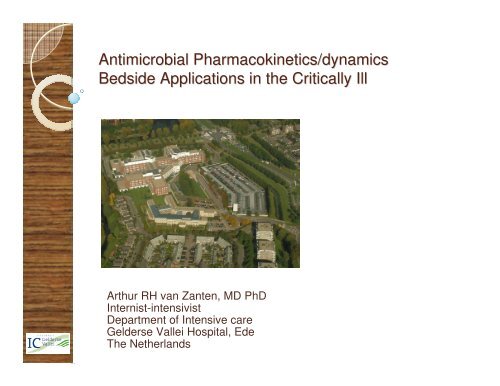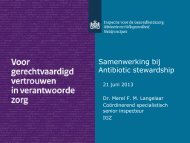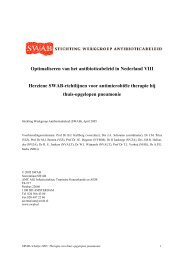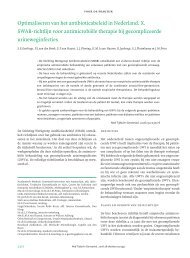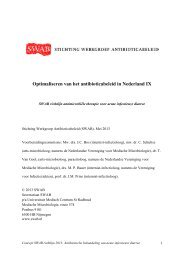Antimicrobial Pharmacokinetics/dynamics Bedside ... - SWAB
Antimicrobial Pharmacokinetics/dynamics Bedside ... - SWAB
Antimicrobial Pharmacokinetics/dynamics Bedside ... - SWAB
You also want an ePaper? Increase the reach of your titles
YUMPU automatically turns print PDFs into web optimized ePapers that Google loves.
<strong>Antimicrobial</strong> <strong>Pharmacokinetics</strong>/<strong>dynamics</strong><strong>Bedside</strong> Applications in the Critically IllArthur RH van Zanten, MD PhDInternist-intensivistDepartment of Intensive careGelderse Vallei Hospital, EdeThe Netherlands
Treatment of ICU patients with antibioticsfrom a clinical perspectiveBacterial infectionBest antibioticOptimum effectBacterial eradication&clinical efficacyAvoid toxicity&adverse effects
Inappropriate therapy and VAP mortalityAlvarez-Lerma F. Intensive Care Med. 1996 May;22(5):387-94Celis R Chest. 1988 Feb;93(2):318-24Kollef MH Chest. 1998 Feb;113(2):412-20Luna CM Chest. 1997 Mar;111(3):676-85.Rello J Am J Respir Crit Care Med. 1997 Jul;156(1):196-200
Timing of adequate antibiotics in septicshock%N = 2154Time in hours afterdocumented hypotensionKumar. Crit Care Med 2006;34:1589-15961596
Antibiotic dosing strategies in renal failure inICUUnderdosingToxicityResistanceImmunocompromisedhostSevereinfections?Nosocomial pathogensReducedeliminationCRRTClinical data
Antibiotics, , PK in wards and ICUHydrophilicantibioticsLipophilic antibioticsGeneral PKLow VdPredominant renal ClLow intracellular penetrationHigh VdPredominant hepatic ClGood intracellularpenetrationAltered ICU PKIncreased VdCl higher or lowerdependent on renal functionVd largely unchangedCl higher or lowerdependent on hepaticfunctionExamplesBeta-lactamsAminoglycosidesGlycopeptidenLinezolidColisitinFluoroquinolonesMacrolidesLincoamidesTigecyclineRoberts. Crit Care Med;37:840-851851
SepsisIncreased CardiacOutputLeaky Capillaries&/oralteredprotein bindingNormal organfunctionEnd OrganDysfunction (e.g.renal or hepatic)Increased ClIncreased VdUnchanged VdDecreased ClLow plasmaconcentrationsNormal plasmaconcentrationsHigh plasmaconcentrationsRoberts. Crit Care Med;37:840-851851
Antibiotics changes in Half-lifelifeT 1/2= 0.693 x VdClIncreased renal perfusionDecreased renal perfusionRenal failureCapillary leakageGold-standard: creatinineclearance (2-hours CL?)Hypalbuminemia (e.g. cetriaxone 95%albumin bound in normalsubjects)Roberts. Crit Care Med;37:840-851851
Continuous Renal Replacement TherapyAanvoerAanvoerDialysaatAanvoerDialysaatatAanvoerTeruggaveteruggaveTeruggaveTeruggaveSubstitutie(pre ofopostdilutie)ISubstitutie(pre ofopost dilutie)EffluentEffluentEffluentEffluentSCUF CVVH CVVHD CVVHDF
Convective Elimination during CVVHBlood flow outCl CVVH= SC XCl CVVHQ UFmembraneSieving Coefficient (SC)SC =[UF][Blood]HemofilterBloodUltrafiltrateBlood flow in
Basic principlesExtracorporeal clearance (Cl EC ) is usually considered clinicallysignificant only if its contribution to total body clearanceexceeds 25 - 30%Fr EC =Cl ECCl EC + Cl R + Cl NRNot relevant for drugs with high non-renal clearanceOnly drug not bound to plasma proteins can be removed byextracorporeal procedures (unbound protein of a drug Fup)Schetz. Curr Opin crit Care 2007;13:645-5151
Loading doseMainly depends on Vd, not eliminationReflection of volume to dissolve drugNo adjustment in renal failure or CVVHVd affected by:◦ Total body water◦ Tissue perfusion◦ Protein binding◦ Lipid solubility◦ pH gradients◦ Active transport mechanismsIncreased loading dose may be required in critically illBouman. Curr Opin Crit Care;14:654-659659
Efficacy and Pharmaco<strong>dynamics</strong>Drug level in bloodPeakU n a c c e p t a b l e t o x i c i t yPeakCmaxIC90TroughCminIC50P o o r a c t i v i t y P o o r a c t i v i t yTime after taking drug
Pharmacodynamic Indices predictive forefficacyT > MIC Cmax / MIC AUC 0-24 / MICTime-dependent Concentration-dependent Concentrationdependentwith timedependencePenicillins Aminoglycosides AminoglycosidesCephalosporins Fluoroquinolones FluoroquinolonesCarbapenems Metronidazole MetronidazoleMonobactams Daptomycin QuinupristinMacrolidesLincoamidesLinezolidAzithromycinGlycopeptidesTetracyclines
Use of ciprofloxacin in the critical care settingFrequently used in critical caresettingEspecially in patients with renalfailure (relative aminoglycosidecontra-indication)Used for gram-negative infectionswith coverage of P. aeruginosainfectionsMIC levels for gram-negativepathogens can vary markedlyDosages of 400 mg bid IV arerecommended for severeinfectionsCiprofloxacin
Ciprofloxacin serum concentrationsafter single bolus IV[ciprofloxacin]1009080706050403020100t in hoursCiprofloxacin pharmacokinetics in criticallyill patients: A prospective cohort study.J Crit Care 2008 Arthur R.H. van Zanten, et al
Quinolones: AUC/MIC > 125AUC above MIC Cmax/MIC (>10)AUC24/MIC Ciprofloxacin: 100-125125Schentag. J Chemother 1999 Dec;11(6):426-39
Volume of distribution (Vd) of ciprofloxacin400 mg bid IV in 32 critically ill patientsA.R.H. van Zanten. J Crit Care 2008
AUC 1-241ciprofloxacin 2 x 400 mg IV in 32critically illAUC/MIC > 100 for different MIC levelsAUC2001801601401201008060402001 3 5 7 9 11 13 15 17 19 21 23 25 27 29 31patientCiprofloxacin pharmacokinetics in criticallyill patients: A prospective cohort study.J Crit Care 2008 Arthur R.H. van Zanten, et al
Pseudomonas aeruginosa isolatesRisk subtherapeutic dosing with 400 mg bidEucast wild type MIC distribution for ciprofloxacin
Simulated fractional attainment of AUC 1-24 24/MIC ratio of 125at MIC 0.25, 0.5, 1.0 and 2.0 mg/l for ciprofloxacin dosages ranging from 800-3200 mg/day based on ICU patient population pharmacokinetics obtained at 800mg/dayCiprofloxacin pharmacokinetics in criticallyill patients: A prospective cohort study.J Crit Care 2008 Arthur R.H. van Zanten, et al
β-lactam Pk/PdTime above MIC• How long?• For all bacteria?• For all β-lactams?• Influence pharmacokinetics?MIC90Time above MICTime
β-lactam static effects: streptococci3210-1R 2 = 89%-2-3-4-5-6T > MIC (%)0 10 20 30 40 50 60 70 80 90Antimicrob Agents Chemother 2008;52:3492-6
β-lactam specific pharmaco<strong>dynamics</strong>: T>MIC3210-1-2-3-4-5-6T > MIC (%)0 10 20 30 40 50 60 70 80 90Andes, Craig. Int J Antimicrob Agents 2002;19:261-8
More antibiotic specific: T > MIC for staticeffectT>MIC static effectEnterobacteriacieae% T > MICS. Pneumoniae% T > MICCeftriaxon 38 (34-42) 39 (37-41)Cefotaxime 38 (36-40) 38 (36-40)Ceftazidime 36 (27-42) 39 (35-42)Meropenem 22 (18-28) -Imipenem 24 (17-28) -Andes, Craig. Int J Antimicrob Agents 2002;19:261-8
Ways to prolong duration of β-lactamconcentrations over MIC1. Use another drug (eg, probenecid) that interferes with itselimination.2. Dose frequently.3. Increase the dose of the antibiotic.4. Replace it with another therapeutically equivalent antibioticwith a longer serum half-life (T 1/2 ).5. Administer it by constant infusion.Quintiliani Infect Med 21(5):219-233, 233, 2004
Randomised, prospective, open single centre study in 93 COPDpatientssuspected or proven pulmonary infection: cefotaximecontinuous infusion: 1 gr loading dose iv, 2 gr/24 hr vs.intermittent infusion: 3 x 1 gr = equivalentMore optimal drug levels at the end of dosing interval duringcontinuous infusion
<strong>Pharmacokinetics</strong> of cefotaxime in 44 ICU patientsP
Systematic review on clinical benefits of continuousadministration of beta-lactan antibioticsSystematic review 14 RCTs (from 59 studies)No difference in clinical cure rateNo difference in mortalityAll studies except one used higher dosages in the bolusgroup potentially favouring this treatment armThe limited data available suggest that CI leads to the sameclinical results as higher dosed bolus administration inhospitalized patientsRoberts, Lipmans et al Crit Care Med 2009; 37:2071-2078
The jury is still out on continuous infusion of beta-lactam antibiotics in critically ill patientsAdvantagesDisadvantagesLower drug acquisitioncostsReduction of work loadTDM more easyAdequate drug levels later(loading dose)Stability of the antibioticHigh MIC, all drug levelssubtherapeuticA well-designed large prospective study on potential advantages of continuousadministation of beta-lacta antibitics in ICU patients is warrantedVan Zanten ARH. Crit Care Med 2009; 37:2137-2138
Total costs of intravenous antibiotic administrationusing different methods of administrationProcedureVolumetricpumpTimerequired(SD) (min:s)Hourlywages(€)Time costs(€)Materialscosts (€)Total costs(€)5:04 (2:29) 21.90 01.85 02.06 03.91Syringe pump 4:56 (2:03) 21.58 01.78 01.45 03.23Bolus injection 9:21 (2:16) 74.09 11.59 00.10 11.69PiggybackinfusionInsertion of IVcatheterRemoval of IVcatheter5:51 (3:33) 19.75 01.93 03.47 05.4010:15 (6:31) 23.51 04.02 04.30 08.3202:22 (0:36) 19.41 00.74 01.00 01.74Importance of nondrug costs of intravenous antibiotictherapy.Arthur RH van Zanten, et al Critical Care 2003, 7:R184-R190 (DOI 10.1186/cc2388)
Daily costs of six antibiotics intravenously administeredby syringe pumpAntibioticAmoxicillin/clavulanic acidDose(mg)1000/200Dosages(n)Drugcosts(€) (A)Averagetime(min:s)Staffcosts (€)(B)Materialcosts (€)(C)Administrationcosts (€)(B+C)Totaldailycosts (€)(A+B+C)3 07.35 12:21 03.99 04.35 08.34 15.69Cefotaxime 1000 4 49.40 18:48 06.08 05.80 11.88 61.28Erythromycin 1000 4 54.44 36:44 11.88 05.80 17.68 72.12Gentamicin 320 1 20.34 03:39 01.18 01.45 02.63 22.97*Pip/Tazo 2250 3 43.14 16:31 05.40 04.35 09.75 52.89Data presented are the medication costs, the time expenditure required, the staff wage and the disposablematerial costs for each of the antibiotics per day administrated via syringe pump. The figures quoted refer tothe total time for preparation and administration of each medication per day, averaged over wards andindications studied. Costs are based on list prices provided by Dutch health care authorities. *If therapeuticdrug monitoring costs for gentamicin based on 24-hourly intervals would be included, the total costs would be€58.97 per day.
The jury is still out on continuous infusion of beta-lactam antibiotics in critically ill patientsAdvantagesDisadvantagesLower drug acquisitioncostsReduction of work loadTDM more easyAdequate drug levels later(loading dose)Stability of the antibioticHigh MIC, all drug levelssubtherapeuticA well-designed large prospective study on potential advantages of continuousadministation of beta-lacta antibitics in ICU patients is warrantedVan Zanten ARH. Crit Care Med 2009; 37:2137-2138
How to dose in renal failure and CVVH?Creatinine clearanceRisk of overdosing in drugs with tubular excretion andunderdosing for drugs with tubular reabsorption (e.g.fuconazole)Estimations of poor qualityDose CVVH= Dose normal XCl nonrenal+Normal Dose (anuric) => Dose CVVH (ratio of normalClclearance and Cl CVVH ) CVVHCl normalAnuric Dose => adjustment using maintenance dosemultiplication factorMDMF = 11 -Fr CVVHTherapeutic Drug MonitoringBouman. Curr Opin Crit Care;14:654-659659
Pk during CVVH various antibiotics35 ml/kg*h 70 kg patientBouman. Curr Opin Crit Care;14:654-659659
<strong>Antimicrobial</strong> Pk/Pd: <strong>Bedside</strong> Applications inthe Critically Ill with Renal Failure<strong>Pharmacokinetics</strong> in critically ill patients are highly variableLoading as normal, consider higher dose in high VdContinuous infusion is a cost-effective, work-load reducingadministration strategyContinuous infusion of beta-lactam antibiotics is feasible for severalantibiotics such as:◦ Cefotaxime◦ Ceftazidime◦ Amoxicillin◦ Penicillin◦ Piperacillin/tazobactamDuring continuous infusion of beta-lactam antibiotics lower totaldaily dosages may be adequate due to more optimalpharmaco<strong>dynamics</strong>
Risk of underdosingHydrophylic antibioticLow protein binding (Fup high)Large Vd, capillary leakageHigh MIC pathogen (nosocomial infections)High dose CVVHAntibiotic with high tubular reabsorptionHow to increase dose?Increase dose in dose dependent killing antibioticsMore frequent dosing or continuous in time dependent antibiotics
<strong>Antimicrobial</strong> Pk/Pd: <strong>Bedside</strong> Applications inthe Critically Ill with Renal FailureIn many infections in ICU patients higher ciprofloxacin dosagesshould be used even in renal failure or alternative antibiotics shouldbe consideredTherapeutic drug monitoring may be used to optimize antibiotictherapyTDM during continuous infusion does require fewer serum samplesDuring therapeutic hypothermia cefotaxime levels are 2 times highercompared to normothermiaICU Pk/Pd data are scarceDuring CVVH: calculate maintenance dose multiplication factor orTDMClinical failure could be due to underdosingTDM maybe also for non-toxic antibioticsKnow or measure MICs for common pathogens in hospital ICUFor nontoxic antibiotics overdosing is preferable to underdosing
Thank you!Arthur van Zantenzantena@zgv.nl


